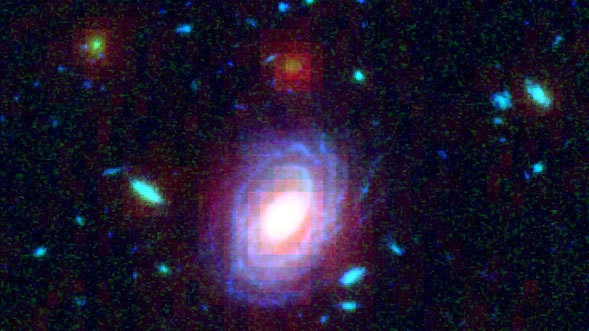
Credit: NASA, ESA/JPL-Caltech/B. Mobasher (STScI/ESA)
Observation • September 27th, 2005 • ssc2005-19a
ssc2005-19a
NASA's Spitzer and Hubble Space Telescopes combined forces to uncover one of the most distant galaxies ever seen. The faraway galaxy, named HUDF-JD2 (in green circles) is not seen in Hubble's visible-light image (upper right), but was detected using Hubble's near infrared camera and multi-object spectrometer (lower left). It appears even brighter at the longer infrared wavelengths, as revealed by the Spitzer infrared camera (lower right).
At visible wavelengths, the light from the galaxy is absorbed by intervening hydrogen gas, and so the galaxy appears faint in the Hubble visible and near-infrared images. The surprise is how bright is appears to Spitzer in the infrared, suggesting a very massive and distant galaxy.
About the Object
- Name
- HUDF-JD2 • UDF033238.74-274839.9
- Type
- Galaxy > Size > Giant
- Distance
- 12,800,000,000 Light Years
- Redshift
- 6.5
Color Mapping
| Band | Wavelength | Telescope |
| Infrared | Spitzer IRAC | |
| Infrared | Hubble NICMOS | |
| Optical | Hubble ACS |
Astrometrics
- Position ()
- RA =3h 32m 28.7s
- Dec = -26° 11' 20.1"
- Field of View
- 0.0 x 0.0 arcminutes
- Orientation
- North is up











